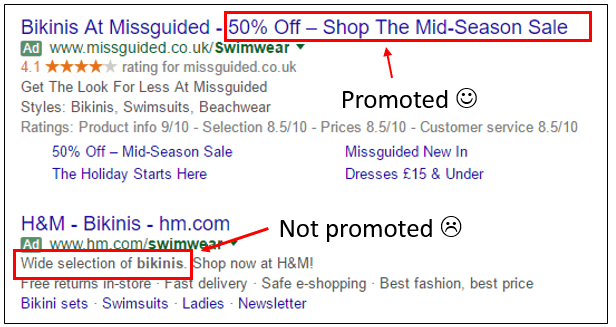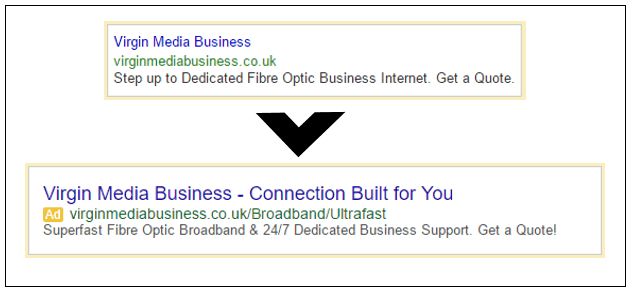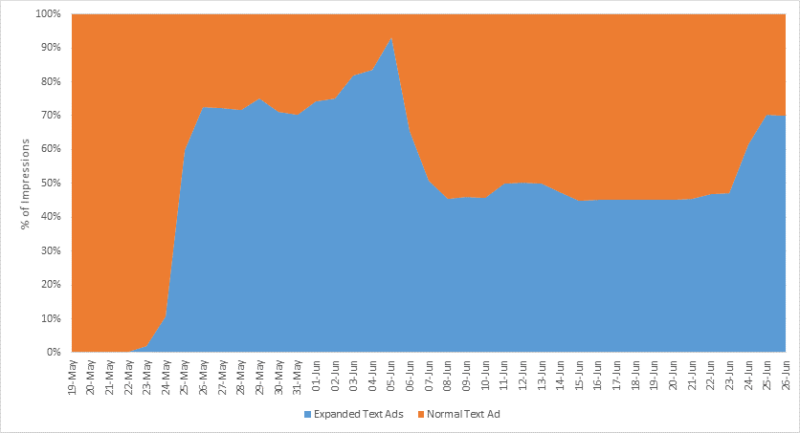Expanded Text Ads: Are they living up to the hype?
Expanded Text Ads will be available to all AdWords advertisers by the end of the year, so how might this impact your accounts? Columnist Laura Collins shares some data from Merkle|Periscopix clients.

Just as the numbers 4-4-2 will be immediately familiar to any soccer fan, 25-35-35 is a combination few people who’ve ever worked in PPC could easily forget.
A 25-character headline and two 35-character description lines have been the building blocks of AdWords text ads since day one. We’ve all slaved away trying to fit compelling copy into these strict limits, desperately tried to knock one character off the first description line to add a full stop at the end, scoured the thesaurus for a shorter synonym… the struggle has been real.
So it was with near-delirious excitement that we at Merkle|Periscopix met Google’s announcement in May that, after testing Expanded Text Ads in a closed beta, they would be rolling them out to all advertisers over the course of this year.
What are Expanded Text Ads?
Previously, we’ve been able to give ad headlines a boost in size, but only at the expense of the description lines. If your first description line ended in a full stop, exclamation or question mark, the ad could be eligible for first line promotion. Your description line was bumped up to the headline ad, and your share of the search results page increased:
But what Google has now given us is 47 percent more characters to play with. Instead of a 25-character headline and two 35-character description lines, we’ve got two headlines (two!) of 30 characters each, plus an 80-character description line. That bigger headline doesn’t come at the expense of your description lines: everything has been super-sized.
As well as increasing the character limits, display URLs have also changed with Expanded Text Ads. Rather than manually entering any URL you like (as long as it matched the domain of the final URL), it’s now automatically extracted from your final URL, and you can customize the rest of it with up to two paths (e.g., /Clothing/Dresses).
Why has Google done this?
Google has been stingy with character limits for years — why the sudden generosity?
It all appears to be part of Google’s shift in focus towards mobile. Mobile is growing, and the AdWords that was built 15 years ago — when all you could do on a phone was talk to someone (imagine) — simply doesn’t cut it anymore.
Step one towards creating a more unified, streamlined experience across devices was the removal of right-hand side ads from desktop in February of this year. This left room for extra text and paved the way for ads which look more uniform across desktop, mobile and tablet.
The ever-evolving power of mobile devices means the lines between them and their desktop/tablet counterparts will continue to blur. Google is acknowledging this with a change that, luckily for us, means significantly more copy with which to get our message across.
How are Expanded Text Ads impacting accounts?
At Merkle|Periscopix, we’ve been implementing Expanded Text Ads in our accounts as soon as they’re available and keeping a very close eye on performance. We looked not only at how well these ads were performing compared to standard ads, but also at how often they were appearing.
It’s still a little too early to draw many definitive conclusions, but some early observations include:
- The percent of impressions for Expanded Text Ads varies dramatically from client to client and from week to week. We’ve seen it vary from as little as 20 percent to around 90 percent for one finance client — although this soon settled to a less dramatic 45 percent:
- Variation in performance between Expanded Text Ads and standard ads can look quite different depending on if you’re looking at “top” or “other.” One travel client found that CTR on Expanded Text Ads was 32 percent higher when appearing in the banner but only 10 percent higher when appearing at the bottom of the page.
- Some clients have even seen worse CTR from Expanded Text Ads, which is a real surprise — not dramatically worse, but it’s still worth bearing in mind that they may not necessarily have a positive impact on your account.
What to remember when implementing Expanded Text Ads
Expanded Text Ads are worth testing in any AdWords account. I can think of few instances where the ability to add more content to your ad could be a negative. And remembering a few handy tips should mean you’re able to make the most of them:
- Don’t assume they’ll achieve better performance than your standard ads and forget about them once they’re implemented. As we’ve seen at Merkle|Periscopix, there are instances where performance can be worse, so ensure that you’re checking back regularly and analyzing performance.
- Label both your Expanded Text Ads and standard ads carefully to make analysis simpler when you’re looking at performance farther down the line.
- Remember, they’re still text ads. Don’t forget to add and optimize your extensions!
- Ensure the data you collect is statistically significant; if Expanded Text Ads are only being served a small percentage of the time, it may take a while before you can draw reliable conclusions.
Contributing authors are invited to create content for Search Engine Land and are chosen for their expertise and contribution to the search community. Our contributors work under the oversight of the editorial staff and contributions are checked for quality and relevance to our readers. The opinions they express are their own.
Related stories


